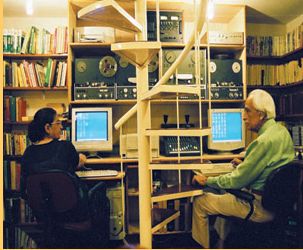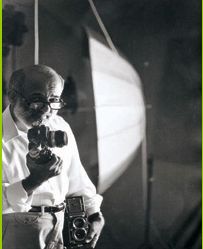Magnificent Obsession
By Shanaz Ramzi | People | Profile | Published 23 years ago
Collectors have existed since time immemorial, and even in an era of crass materialism, more and more people are spending a considerable portion of their time and money on building up collections of things that take their fancy. While there are countless people with impressive collections of stamps, coins, postcards, matchboxes, books and other traditionally popular collector’s items, Shanaz Ramzi talks to a few who have taken great trouble to collect items that may well be considered priceless.
Lutfullah Khan
 Take for instance, the collection of the renowned octogenarian Lutfullah Khan. Ranging from knick-knacks and memorabilia painstakingly saved right from his childhood to the present day — which reflect his disciplined and meticulous disposition — to an exclusive audio and photo collection, his act is a difficult one to follow.
Take for instance, the collection of the renowned octogenarian Lutfullah Khan. Ranging from knick-knacks and memorabilia painstakingly saved right from his childhood to the present day — which reflect his disciplined and meticulous disposition — to an exclusive audio and photo collection, his act is a difficult one to follow.
Khan has been a collector ever since he can remember, preserving things that one normally uses and discards. Hence, he has things in his collection that he used as a youth, which in this last half a century or so have become rare items. While it is amazing enough that he has retained these objects, the way he has preserved them is even more fascinating. A large portion of his home has been converted into an exhibition hall, its walls lined with glass cabinets and desks displaying the exhibits. Each of the glass desks is equipped with a built-in bulb to facilitate the viewer and has clear and precise information about its contents pasted on neat metal plates.
Lutfullah’s collection includes a wide array of stationery that he used in his heyday when he used to sketch and draw. Ranging from paint pencils, flat pencils, colour pencils in lead encasings, penholders and quills, to sharpeners, clips, clamps, punching machines, glues, magnifying apparatus, labelling machines, drawing gadgets and cutting instruments, the materials are half a century old and in immaculate condition.
A detailed tour of this room could well take an hour, transporting you down memory lane as you see many items that were once in vogue. Round, plastic needle boxes with different slots for the various needle sizes; plastic bell-shaped clamps for sealing polythene bags; ancient radios, speakers and spool tape-recorders are just a few of the gadgets on display.
Among Lutfullah’s most interesting collections are the ones titled ‘Accessories and accompaniments to an evening dinner wear,’ which display items used by gentlemen of yore, such as opera glasses, comb cases, plastic toothpicks and travel requisites for men — containing every conceivable prerequisite for a seasoned traveler, ranging from travelling clock and sewing kit to bottles of shampoo, powder, lotions, etc. Aside from these, there are showcases with sable and hog-hair brushes, smoking requisites and old photo and movie equipment, some of which were manufactured by companies that have long since closed down.
Another fascinating aspect of Lutfullah’s collection are the pamphlets that used to be distributed with cinema and theatre tickets some seventy years ago. Neatly stuck in albums carrying the names and pictures of the artistes of the early thirties, they have been been systematically categorised under the labels of ‘Six artistes of highest repute,’ ‘Western movie male artistes of higher repute’ and so on. Similarly, cover labels of safety matchboxes from about the same period have been maintained in a scrapbook.
Lutfullah also has a coin collection. His collection includes Pakistani coins made of silver, nickel and copper that are no longer minted, like the two anna, one rupee and five paisa coin. Lutfullah also has 3500 photographs on various themes such as flowers, Pakistani mosques, Muslim shrines, architectural sites, artists and literati of Pakistan and much more.
What really makes Lutfullah stand out as a unique collector is his personal file collection maintained in a separate room. Records of practically every important development in his life have been preserved in meticulously marked filing cabinets. The ones marked ‘personal,’ for example, have files in alphabetical order and include invitation cards to his circumcision (printed in 1925), bills of hotels he stayed in, in 1945, and correspondence with local clubs that dates back to the fifties .
He has an audio collection that he claims has no parallel in the world, comprising spool tapes on a vast variety of subjects such as fine arts (with interviews of artists), religion, literature, music and speeches. In fact, with time taking its toll on this 50-year old priceless collection, Lutfullah along with his wife, has now taken on the mammoth task of transferring his audio collection from analogue to digital.
Suleman Tahir
 Suleman Tahir has been an ardent collector of unusual cameras since 1980. He has 560 cameras and over 1000 lenses in his possession. Suleman’s criterion for adding a camera to his collection is that it should have some unique feature. It need not necessarily be an antique — although he has many that qualify as such — and could be a brand new camera that might be a collectors’ edition, for instance, or one that had been previously owned by a well-known personality. Among those in the former category is a more than a century old panoramic camera that makes negatives of a special size and has a sweeping movement of the lens, enabling it to cover a wide area. A 1901 model, Suleman claims that it is of amazing quality and still in functioning order.
Suleman Tahir has been an ardent collector of unusual cameras since 1980. He has 560 cameras and over 1000 lenses in his possession. Suleman’s criterion for adding a camera to his collection is that it should have some unique feature. It need not necessarily be an antique — although he has many that qualify as such — and could be a brand new camera that might be a collectors’ edition, for instance, or one that had been previously owned by a well-known personality. Among those in the former category is a more than a century old panoramic camera that makes negatives of a special size and has a sweeping movement of the lens, enabling it to cover a wide area. A 1901 model, Suleman claims that it is of amazing quality and still in functioning order.
Another unusual miniature antique camera, which is still operational, is one that was used during World War II by the Nazis. A 1915 Kodak model called ‘Pocket 1 A’ is yet another fascinating piece in his collection. The name belies its appearance, for it is actually twice the size of an ordinary camera and about thrice the size of an Instamatic. This camera has an added feature — a pen (which looks like a thick needle) with which one can inscribe a message on the film through a window in the camera. He claims it takes better pictures than most modern cameras. Another rare camera, allegedly worth millions, has the one-time compulsory inscription, ‘Made in occupied Japan,’ engraved on it.
Among the not so old but unique cameras is one that uses a long roll of film, enabling it to take up to 250 photographs without requiring fresh film. Another snaps six consecutive photographs per second, while a third can shoot photographs underwater up to a depth of 60 metres. He is also very proud of his collectors’ edition of a Canon camera, a commemorative issue produced in limited quantities (only 10,000 pieces were manufactured), which is smaller in size than a mobile telephone. Suleman also owns a stereo camera, which snaps two photographs simultaneously from slightly different angles, giving a three-dimensional effect, if viewed with a special viewfinder.
Then there are the sheet film cameras, which take only one photograph at a time, the negatives of which are of average size, and one with the fastest ever lens, that transmits more light than it receives. But, perhaps the camera that offers the largest number of features in Suleman’s collection is the one that takes pictures in total darkness and can automatically control the flash output required and the distance at which it should be set. It can also be pre-programmed at a variety of settings, for as long a period as 999 days.
Quite a few of Suleman’s cameras cannot be used because the film format is no longer available, while some 30 or so cameras are not in working condition. Suleman has not discarded them, however, because they represent a particular time period and throw light on the technology of the time.
Suleman buys most of his cameras locally from obscure shops in small towns, which tend to keep old cameras. He also purchases them through advertisements in the newspapers. He claims that he never sells a camera if it is more than 50 years old, as it would be difficult to replace it with another piece as old. Sadly, though, because of security constraints there is no proper display of this impressive collection.
The writer is a freelance journalist based in Karachi. She also works at Hum television.
No more posts to load


